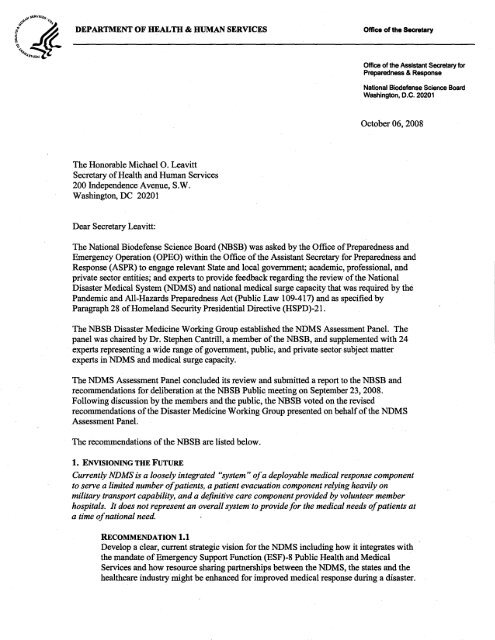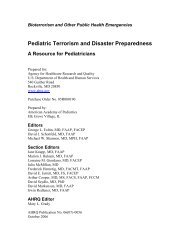NBSB letter to sec, NDMS, 09-23-08 - PHE Home
NBSB letter to sec, NDMS, 09-23-08 - PHE Home
NBSB letter to sec, NDMS, 09-23-08 - PHE Home
You also want an ePaper? Increase the reach of your titles
YUMPU automatically turns print PDFs into web optimized ePapers that Google loves.
DEPARTMENT OF HEALTH & HUMAN SERVICES<br />
Office of the Secretary<br />
Office of the Assistant Secretary for<br />
Preparedness & Response<br />
National Biodefense Science Board<br />
Washing<strong>to</strong>n, D.C. 20201<br />
Oc<strong>to</strong>ber 06, 20<strong>08</strong><br />
The Honorable Michael O. Leavitt<br />
Secretary ofHealth and Human Services<br />
200 Independence Avenue, S.W.<br />
Washing<strong>to</strong>n, DC 20201<br />
Dear Secretary Leavitt:<br />
The National Biodefense Science Board (<strong>NBSB</strong>) was asked by the Office ofPreparedness and<br />
Emergency Operation (OPEO) within the Office ofthe Assistant Secretary for Preparedness and<br />
Response (ASPR) <strong>to</strong> engage relevant State and local government; academic, professional, and<br />
private <strong>sec</strong><strong>to</strong>r entities; and experts <strong>to</strong> provide feedback regarding the review ofthe National<br />
Disaster Medical System (<strong>NDMS</strong>) and national medical surge capacity that was required by the<br />
Pandemic and All-Hazards Preparedness Act (Public Law 1<strong>09</strong>-417) and as specified by<br />
Paragraph 28 of<strong>Home</strong>land Security Presidential Directive (HSPD)-21.<br />
The <strong>NBSB</strong> Disaster Medicine Working Group established the <strong>NDMS</strong> Assessment Panel. The<br />
panel was chaired by Dr. Stephen Cantrill, a member ofthe <strong>NBSB</strong>, and supplemented with 24<br />
experts representing a wide range ofgovernment, public, and private <strong>sec</strong><strong>to</strong>r subject matter<br />
experts in <strong>NDMS</strong> and medical surge capacity.<br />
The <strong>NDMS</strong> Assessment Panel concluded its review and submitted a report <strong>to</strong> the <strong>NBSB</strong> and<br />
recommendations for deliberation at the <strong>NBSB</strong> Public meeting on September <strong>23</strong>, 20<strong>08</strong>.<br />
Following discussion by the members and the public, the <strong>NBSB</strong> voted on the revised<br />
recommendations ofthe Disaster Medicine Working Group presented on behalf ofthe <strong>NDMS</strong><br />
Assessment Panel.<br />
The recommendations of the <strong>NBSB</strong> are listed below.<br />
1. ENVISIONING THE FUTURE<br />
Currently <strong>NDMS</strong> is a loosely integrated "system" ofa deployable medical response component<br />
<strong>to</strong> serve a limited number ofpatients, a patient evacuation component relying heavily on<br />
military transport capability, and a definitive care component provided by volunteer member<br />
hospitals. It does not represent an overall system· <strong>to</strong> provide for the medical needs ofpatients at<br />
a time ofnational need.<br />
RECOMMENDATION 1.1<br />
Develop a clear, current strategic vision for the <strong>NDMS</strong> including how it integrates with<br />
the mandate ofEmergency Support Function (ESF)-8 Public Health and Medical<br />
Services and how resource sharing partnerships between the <strong>NDMS</strong>, the states and the<br />
healthcare industry might be enhanced for improved medical response during a disaster.
Page 2 Memorandum <strong>to</strong> Secretary, U.S. Department of Health and Human Services<br />
RECOMMENDATION 1.2<br />
Establish an ongoing civilian advisory group for the National Disaster Medical System<br />
and for the U.S Department ofHealth and Human Services (HHS) ESF-8 efforts in<br />
general. This group should meet on a regular basis and assist in the ongoing assessment<br />
and improvement ofour nation's disaster medical response.<br />
2. INTEGRATING THE PAST<br />
Multiple previous studies and after-action reports have identified opportunities for improvement<br />
in the <strong>NDMS</strong>, however, there does not appear <strong>to</strong> be an organized methodology <strong>to</strong> track and<br />
moni<strong>to</strong>r attempts <strong>to</strong> address theseidentified issues resulting in lost opportunities <strong>to</strong> continually<br />
improve the performance ofthe NDM8.<br />
RECOMMENDATION 2.1<br />
Establish a formal mechanism <strong>to</strong> track the implementation of recommendations and<br />
lessons-learned from appropriate after-action reports and other evaluations. This<br />
process should identify the fac<strong>to</strong>rs which have precluded effective implementation of<br />
previous recommendations, such as insufficient staff, staff turnover, unclear<br />
responsibilities, lack of funding, etc., sothat these primary issues may be addressed.<br />
3. STRENGTHENING THE TEAM<br />
Medical response personnel are one ofthe mission critical resources, which allows the <strong>NDMS</strong><br />
<strong>to</strong> fulfill its mission ofassisting State and local authorities in dealing with the medical impacts<br />
ofmajor peacetime disasters.<br />
RECOMMENDATION 3.1<br />
Every effort should be made <strong>to</strong> achieve full staffing and operational status for all <strong>NDMS</strong><br />
Response Teams. This includes dealing with identified issues in the following<br />
Response Team areas: concept ofoperations, equipment and logistics, command and<br />
control, communications and training.<br />
RECOMMENDATION 3.2<br />
Establish a uniform and consistent training curriculum across each of the types of<br />
volunteer teams consistent with the education and training requirements as defined<br />
under HSPD-21. These efforts must be complementary and build upon a national,<br />
standardized approach for resource typing, uniform training, field deployment and<br />
logistics support.<br />
RECOMMENDATION 3.3<br />
Implement an accounting/tracking system that can properly register the true capacity of<br />
non-overlapping <strong>NDMS</strong> medical response personnel who can be deployed for an event.<br />
Consideration should be given <strong>to</strong> improving the <strong>NDMS</strong> personnel capability and gap<br />
analysis for multiple specified national scenarios, including consideration of conflicting<br />
obligations and time <strong>to</strong> respond.<br />
4. SERVING THE PATIENT<br />
By definition members ofthe public will only ever interact with the National Disaster Medical<br />
System in times ofincredible stress and strain <strong>to</strong> the public and thehealthcare system. The<br />
<strong>NDMS</strong> needs <strong>to</strong> ensure that its procedures and policies do not add unnecessary physical,<br />
emotional orfinanCial stresses <strong>to</strong> the individuals that it serves. Particular attention needs <strong>to</strong> be<br />
paid <strong>to</strong> smooth and efficient mass evacuation ofpatients from impacted areas including the<br />
continuity ofpatient medical information during and after transport.
Page 3 Memorandum <strong>to</strong> Secretary, U.S. Department of Health and Human Services<br />
RECOMMENDATION 4.1<br />
Review and expand the defmition, ifnecessary, ofwhat constitutes an <strong>NDMS</strong> patient.<br />
Serious consideration should be given <strong>to</strong> including any individual evacuated across state<br />
lines (regardless ofmode ofevacuation) due <strong>to</strong> a disaster, who requires medical<br />
evaluation or care, <strong>to</strong> be an <strong>NDMS</strong> patient for a specified limited period oftime<br />
(including long-term care patients).<br />
RECOMMENDATION 4.2<br />
Reimbursement for care ofdisaster victim patients should not be limited <strong>to</strong> just <strong>NDMS</strong><br />
hospitals, but should include all hospitals, outpatient clinics, nursing homes, alternate<br />
care facilities, shelters, etc, wherever care is provided during the time ofthe event or the<br />
following impact period. Reimbursement should continue at 110% ofthe Centers for<br />
Medicare and Medicaid Services' rate.<br />
RECOMMENDATION 4.3<br />
Establish a standard patient movement concept ofoperation. This plan should explicitly<br />
address the needs and management ofat-risk individuals including children, pregnant<br />
women, senior citizens, and individuals with medical disabilities and other special<br />
needs, in the event of a disaster or public health emergency.<br />
RECOMMENDATION 4.4<br />
Field usability ofthe <strong>NDMS</strong> Electronic Medical Record (EMR) currently under<br />
development must be the goal of primary importance for its implementation. To the<br />
degree possible, integration of the <strong>NDMS</strong> EMR platform with future patient tracking<br />
and medical resource availability systems should be encouraged. The <strong>NDMS</strong> EMR<br />
platform should use medical IT best practices and pro<strong>to</strong>cols that will allow the greatest<br />
degree ofinteroperability with existing and future EMR systems. <strong>NDMS</strong> should take<br />
the lead in defming the minimal patient data set that is required in a patient tracking<br />
system.<br />
RECOMMENDATION 4.5<br />
Undertake a comprehensive review of federal health-related regulations and determine<br />
how such regulations pose barriers <strong>to</strong> the efficient and effective administration of<br />
patient care during times ofextreme medical need. Develop criteria <strong>to</strong> specify when<br />
health-related federal regulations should be considered for temporary suspension in<br />
areas affected by a disaster and potentially those areas receiving the evacuated patients<br />
and convey these criteria <strong>to</strong> the healthcare community <strong>to</strong> assist in their disaster<br />
preparedness planning.<br />
5. ENGAGING PARTNERS<br />
The complete integration offederal resources with state and local resources is problematic.<br />
The process would benefit from establishing an improved understanding ofeach others<br />
capabilities and needs in advance. This is felt <strong>to</strong> be a significant issue especially for the<br />
Disaster Mortuary Operational Response Teams in terms ofdealing with issues such as body<br />
disposition, which remains a local responsibility.<br />
RECOMMENDATION 5.1<br />
Consistent with Recommendation 1.1 the <strong>NDMS</strong> should improve and expand its efforts<br />
<strong>to</strong> build sustainable partnerships with State and local resources.
Page 4 Memorandum <strong>to</strong> Secretary, U.S. Department of Health and Human Services<br />
RECOMMENDATION 5.2<br />
Establish improved alliances between <strong>NDMS</strong> and the public/private healthcare <strong>sec</strong><strong>to</strong>r <strong>to</strong><br />
provide assistance in field care, patient transport and definitive patient care. These<br />
alliances should be designed <strong>to</strong> provide additional assets <strong>to</strong> augment <strong>NDMS</strong> operations<br />
during a time of national need.<br />
6. ALLOCATING RESOURCES<br />
It is clear that funding levels for the <strong>NDMS</strong> are inadequate <strong>to</strong> support even the current level of<br />
the <strong>NDMS</strong> operation.<br />
RECOMMENDATION 6.1<br />
Every effort should be made <strong>to</strong> <strong>sec</strong>ure adequate, sustained, increased funding for the<br />
<strong>NDMS</strong> so it may successfully accomplish its critically important mission.<br />
7. MOVING TOWARD THE FUTURE<br />
RECOMMENDATION 7.1<br />
The ASPR should consider this report and recommendations ofthe <strong>NBSB</strong>. The <strong>NBSB</strong><br />
would respectfully request feedback at our spring / summer 20<strong>09</strong> meeting concerning<br />
each recommendation above as <strong>to</strong> whether it has: 1) already been implemented; 2) will<br />
be implemented or 3) will not be implemented, with reasons ifpossible.<br />
RECOMMENDATION 7.2<br />
As follow-up <strong>to</strong> the <strong>NBSB</strong> report, the HHS/ASPR should request a study by the<br />
Institute of Medicine that would assess and evaluate the current status and progress of<br />
the <strong>NDMS</strong> program and make recommendations for future directions.<br />
In addition <strong>to</strong> these specific recommendations, the <strong>NBSB</strong> is including for your consideration the<br />
full report of the Disaster Medicine Working Group <strong>NDMS</strong> Assessment Panel that was adopted<br />
by the <strong>NBSB</strong>. This report provides greater context <strong>to</strong> many of the <strong>NBSB</strong>'s recommendations<br />
listed here.<br />
Time and again our nation is faced with adversity taking the shape of natural disasters, major<br />
transportation accidents, technological disasters, and acts ofterrorism including weapons of mass<br />
destruction events; therefore, the <strong>NBSB</strong> feels that the above recommendations should be taken<br />
in<strong>to</strong> thoughtful consideration, in efforts <strong>to</strong> protect, preserve, and advance the <strong>NDMS</strong> ofHHS.<br />
Sincerely,<br />
( \.'<br />
Patricia Quinlisk, M.D., M.P.H. <br />
Chair, National Biodefense Science Board <br />
Attachments: Disaster Medicine Working Group <strong>NDMS</strong> Assessment Panel Report
















